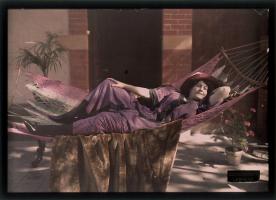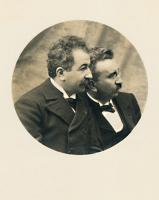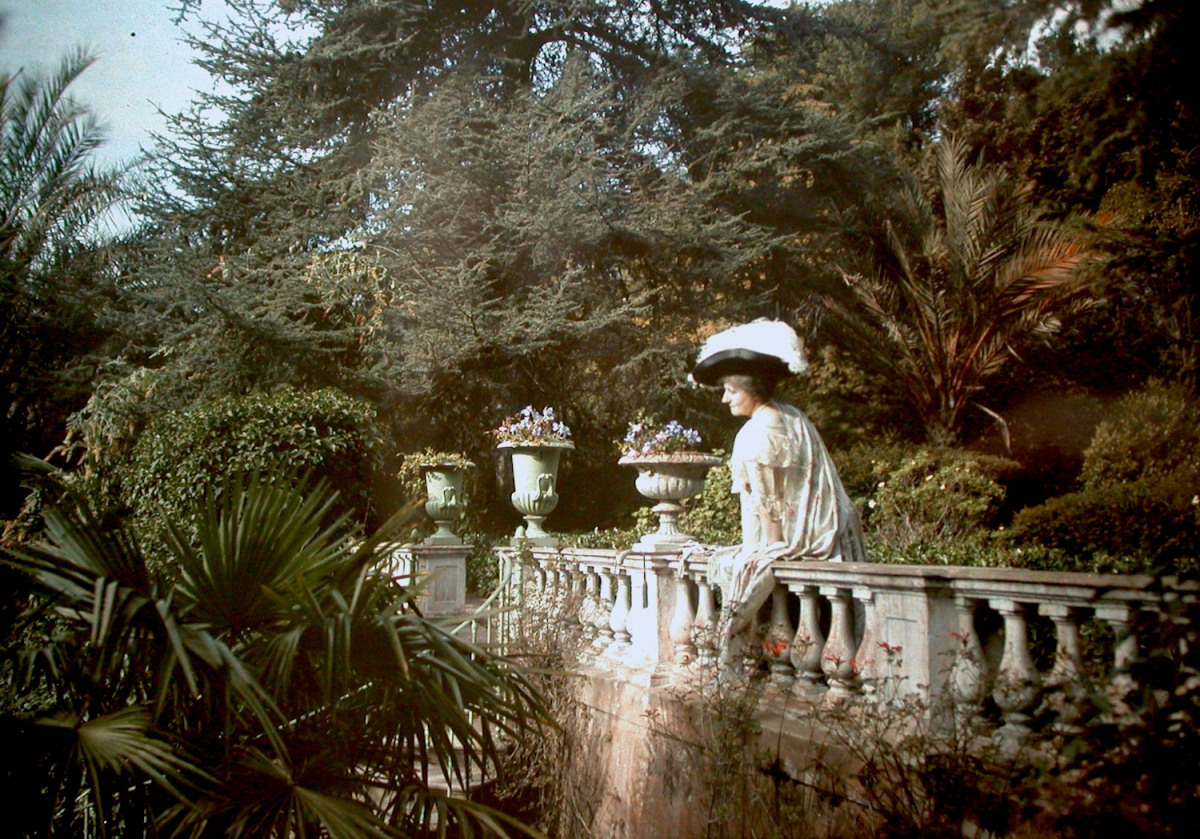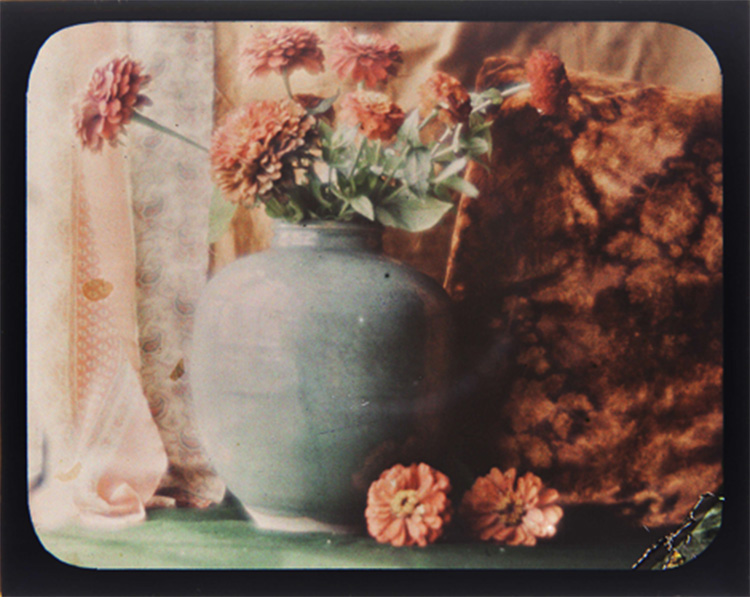
Jean-Baptiste Tournassoud--Geo in Hammock
The first version of the Autochrome, which was the first practical color process, was patented on December 17th, 1903 by the brothers Auguste and Louis Lumiére of Lyons, France (FR.Pat.No. 339.223). This first version of the Autochrome was also applied for in 1904 and then patented in America on June 5, 1906 (No.822.532). For the American patent application, go to http://www.vintagephoto.tv/patents.shtml, and scroll down the page to "August and Louis Lumière - Photographic Plate for Color Photography, 1906". The Autochrome is an additive color process that produces its color image by a blend of tiny red, green and blue dots of color.
The Lumieres had been interested in color photography for years. In the 1890s they had experimented with Professor Gabriel Lippmann's interference heliochromy process (footnote: Lippmann won the Nobel prize for physics in 1908 for this photographic process http://nobelprize.org/physics/laureates/1908/ , the only 'photographic' Nobel prize ever won.) This was a beautifully elegant solution to the problem of how to produce color photographic images but unfortunately it needed rather long exposures (portraiture would simply not have been possible).

Lumiere Brothers
In the 1900 Paris Exposition they exhibited examples of another process they had been working on in the 1890s, their 'bichromated glue' color process, also called trichromes. This subtractive color process used three superimposed layers dyed either magenta, cyan or yellow. The results were stunning, 'characterized by a richness of coloring and luminosity that far exceeded all previous work' (E J Wall, 'The History of Three Color Photography') but again the exposure time meant that only still lifes, landscapes and similar static subjects could be photographed. It also necessitated three separation glass-plate negatives to make the positives.
Examples of this process can occasionally be found today but are often in less than perfect condition. This is usually the result of differential expansion; the glue layers expand or contract in response to changes in atmospheric humidity, whereas the glass support does not. This produces stresses that can lift the emulsion from the glass or even cause the layers to separate and tear.
It was not until 1907 that commercial production of Autochrome plates commenced. The Autochrome screen was created by forming a layer of minute starch grains as small as 6,000-7,000 grains per square millimeter, each dyed in one of the primary colors (red, blue and green) and then varnished. Some sources indicate the colors were actually orange (or orange-red), green and blue-violet, at least by the revised patent application approved in the U.S. by 1906. There is also some dispute on whether or not potato starch was used (although this was clearly the material used early on) or eventually exchanged for other finer particle starches (the American patent does not specify potato). The Lumieres also patented the use of dyed yeast grains for this application. The gaps between the starch grains were largely filled by squashing the grains with a roller to make them touch one another. Carbon black was then applied over the plate to fill in any remaining spaces around the starch grains. Once the screen was formed a panchromatic silver gelatin emulsion was applied over the color screen. When the plate was exposed, the base side was turned toward the subject being photographed, and the color screen acted as a filter over the emulsion. The plate was developed to produce a positive with delicate color qualities. The plates were fast enough for portraiture in good light and did not need three separation negatives.
Often frosted glass plates were used as covers, acting as a diffuser to give a more even illumination and prevent an image of the light source being seen through the plate. The frosted glass increased the soft focus quality of the color starch grains, which formed the Autochrome image. This positive pointillist image meshed beautifully with the times, emulating Post-Impressionist art.
Autochromes soon became very popular with the Symbolist and Viennese Secession movements, as well as with the Photo Impressionists and common tourists. Noted photographers who used the process included Alfred Stieglitz, Eduard Steichen, Baron De Meyer, George Seeley, Henrich Kuhn, Arnold Genthe, Alvin Langdon Coburn, Karl Struss, Marcel Meys, Hugo Viewegar and many others.
Autochromes came in many sizes to fit many cameras, from less than two inches square to 15 x 18 inches. There were also stereo formats.
In common with other types of photographs, both the glass base and the process used to create Autochromes are subject to deterioration. Glass is easily broken and can decay if stored in too humid conditions, and dyes can fade. Autochromes without a protective cover glass easily sustain physical damage. Scratched and peeling emulsion layers and faded colors are common. To protect the emulsion, plates were often varnished and a protective cover glass applied and secured with paper tape.
Common conservation treatments include retaping seals, reattachment of peeling emulsion and replacement of broken glass cover sheets.
A common way of viewing Autochromes was to use a diascope. A frame at the top holds the Autochrome plate allowing light from above to pass through the plate and strike a mirror inside the device. The mirror is shielded from ambient light by cloth side panels. The viewer looks into the diascope and sees the reflection of the illuminated Autochrome.
Autochrome photography flourished from 1907 to the 1930s. Because the process does not produce a negative, each Autochrome is a unique transparency image. In 1931 or 1932 a film-based version of the Autochrome was launched under the name 'Filmcolor'. This had two main advantages, it was both lighter to carry and photographically faster. It remained in production until the 1950s, undergoing several technical improvements and changes in name.
One museum that focuses on the Autochrome is the Albert-Kahn museum in Boulogne, France, which houses 72,000 Autochrome plates. John Wood's excellent book, The Art of the Autochrome, is readily available from many sources.
Dating Autochromes
While some autochrome boxes do have expiration dates faintly inscribed, such dating to plates inside the boxes is often highly suspect, as boxes are and were often reused/repurposed, etc.
To make matters worse, many boxes do not have visible expiration dates. Some of those boxes though may still be dated using the following fabrication numbers that may be easier to see on the box, remembering that these numbers may not date the contents of the box exactly. You will notice that the numbers are not a consistent string as the dates go up. Information and data on dating autochromes below is courtesy of Jean-Paul Gandolfo, Hans Rooseboom, curator of Photography at the Rijksmuseum Amsterdam, and Mark Jacobs. Gandolfo's book with Bertrand Lavédrine, "L’autochrome Lumière, secrets d’atelier et défis industriels", is considered by many to be far and away the best book on the industrial process which produced the autochrome.
According to Mark Jacobs, one other method that can be used to date boxes should the expiration date no longer be visible is to see how the name Lumiere appears on the top of the box. A "Societe Lumiere" nameplate will date it from before 1911. If the name appears as "Union Photographique Industrielle Lumiere & Jougla (U.P.I .)" then the box was manufactured after Lumiere & Jougla joined forces in 1911. Of course, there is no guarantee that exposed plates remained in the same box in which they were shipped.
The type of varnish used and other factors may also be used in dating autochromes, but such dating usually requires the use of an x-ray fluorescence spectrometer, which puts the cost quite high and usually out of reach of non-institutional collectors. A full description of these variations and how they were analyzed can be found in the chapter "Photography in Natural Colors: Steichen and the Autochrome Process" by Tinia Passafiume, and "Coatings on Autochrome Plates" by Bertrand Lavedrine, Clara von Waldthausen, and Lyzanne Gann in "Coatings on Photographs. Materials, Techniques, and Conservation", edited by Constance McCabe, 2005, AIC.
The list of numbers and corresponding visible dates on boxes reported by several of the people mentioned above are listed below:
181: August 1908
331: September 1909
350: October 1909
383: 15 January 1910
518: November 1910
604: July 1911
712: November 1911
713: October 1911
828: July 1912
833: July 1912
928: October 1912
957: December 1912
959: idem
1058: August 1913
1091: September 1913
1113: October 1913
1116: idem
1130: November 1913
1158: December 1913
1207: May 1914
1238: July 1914
1245: August 1914
1288: End of September 1914
1314.1 October 1914
1318-2: End of November 1914
1483: February 1918
1487-2: 2 May 1918
1540: February 1920
1575-1: November 1920
1579-2: February 1921
1618-1: October 1921
1668-2: End of September 1922
1607: October 192?
1661-2: ? 192?
1675-1: November 1922
1798: August 1923
1710: August 1923
1934: November 1923
1733: date unreadable
1744-2: April 1924
1775: September 1924
1786: End of November 1924
1800-2: April 1925
1718: September 1926?
2867: May 1926
1911: December 1926
1936: 1927
1947: November 1927
1949: November 1927
2961: June 1928
2007-2: August 1929
2043-2: August 1930
2050: 1936
Exhibited and Sold By
Contemporary Works / Vintage Works, Ltd.
258 Inverness Circle
Chalfont, Pennsylvania 18914 USA
Contact Alex Novak and Marthe Smith
Email info@vintageworks.net
Phone +1-215-518-6962
Call for an Appointment














Share This